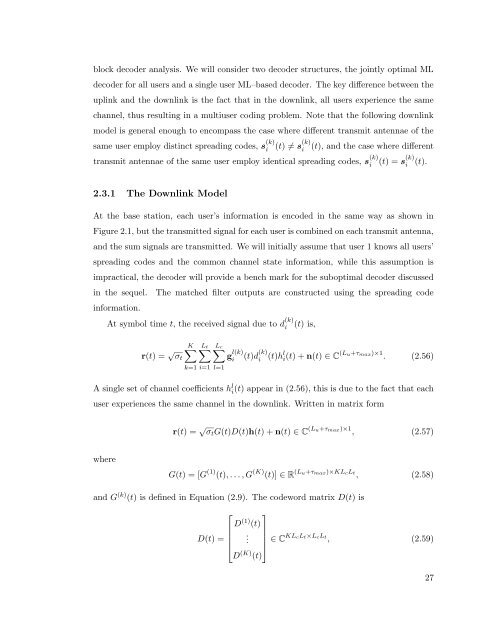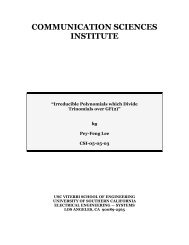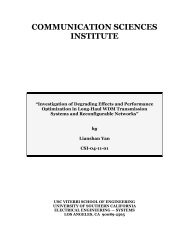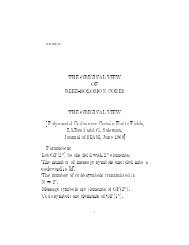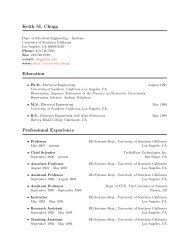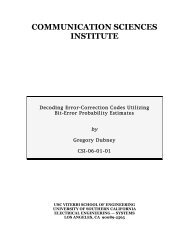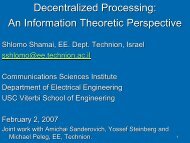Space-Time Block Codes for Wireless Systems - The ...
Space-Time Block Codes for Wireless Systems - The ...
Space-Time Block Codes for Wireless Systems - The ...
You also want an ePaper? Increase the reach of your titles
YUMPU automatically turns print PDFs into web optimized ePapers that Google loves.
lock decoder analysis. We will consider two decoder structures, the jointly optimal ML<br />
decoder <strong>for</strong> all users and a single user ML–based decoder. <strong>The</strong> key difference between the<br />
uplink and the downlink is the fact that in the downlink, all users experience the same<br />
channel, thus resulting in a multiuser coding problem. Note that the following downlink<br />
model is general enough to encompass the case where different transmit antennae of the<br />
same user employ distinct spreading codes, s (k)<br />
i<br />
(t) ≠ s (k)<br />
i<br />
(t), and the case where different<br />
transmit antennae of the same user employ identical spreading codes, s (k)<br />
i<br />
(t) = s (k)<br />
i<br />
(t).<br />
2.3.1 <strong>The</strong> Downlink Model<br />
At the base station, each user’s in<strong>for</strong>mation is encoded in the same way as shown in<br />
Figure 2.1, but the transmitted signal <strong>for</strong> each user is combined on each transmit antenna,<br />
and the sum signals are transmitted. We will initially assume that user 1 knows all users’<br />
spreading codes and the common channel state in<strong>for</strong>mation, while this assumption is<br />
impractical, the decoder will provide a bench mark <strong>for</strong> the suboptimal decoder discussed<br />
in the sequel.<br />
in<strong>for</strong>mation.<br />
<strong>The</strong> matched filter outputs are constructed using the spreading code<br />
At symbol time t, the received signal due to d (k)<br />
i<br />
(t) is,<br />
r(t) = √ σ t<br />
∑<br />
∑<br />
K ∑L t L c<br />
k=1 i=1 l=1<br />
g l(k)<br />
i<br />
(t)d (k)<br />
i<br />
(t)h l i(t) + n(t) ∈ C (Lu+τmax)×1 . (2.56)<br />
A single set of channel coefficients h l i (t) appear in (2.56), this is due to the fact that each<br />
user experiences the same channel in the downlink. Written in matrix <strong>for</strong>m<br />
r(t) = √ σ t G(t)D(t)h(t) + n(t) ∈ C (Lu+τmax)×1 , (2.57)<br />
where<br />
G(t) = [G (1) (t), . . . , G (K) (t)] ∈ R (Lu+τmax)×KLcLt , (2.58)<br />
and G (k) (t) is defined in Equation (2.9). <strong>The</strong> codeword matrix D(t) is<br />
⎡ ⎤<br />
D (1) (t)<br />
D(t) = ⎢ . ⎥<br />
⎣ ⎦ ∈ CKLcLt×LcLt , (2.59)<br />
D (K) (t)<br />
27


